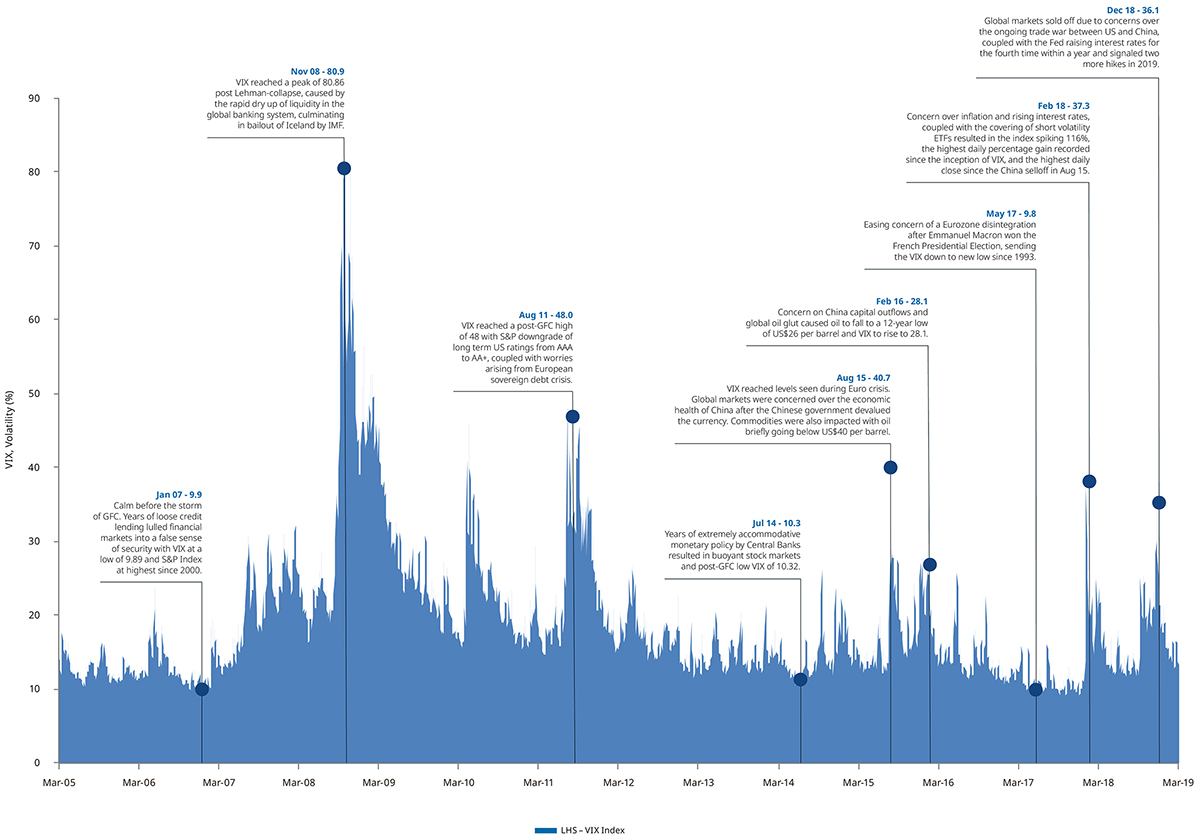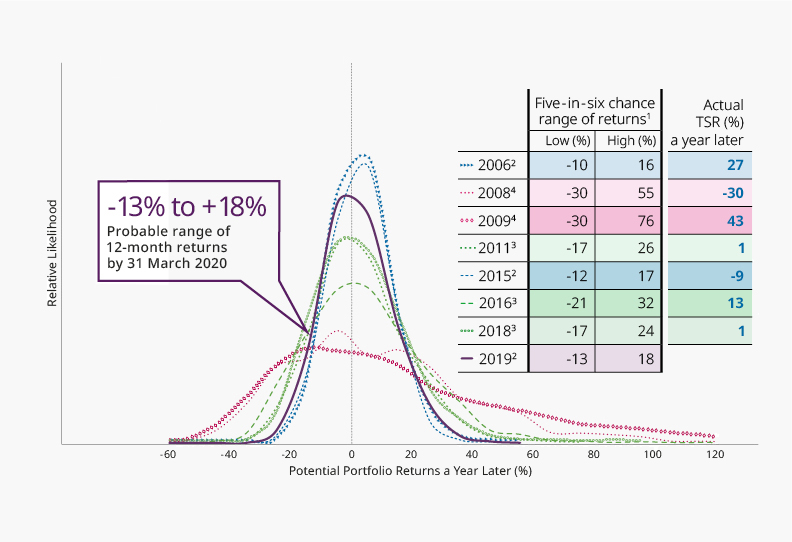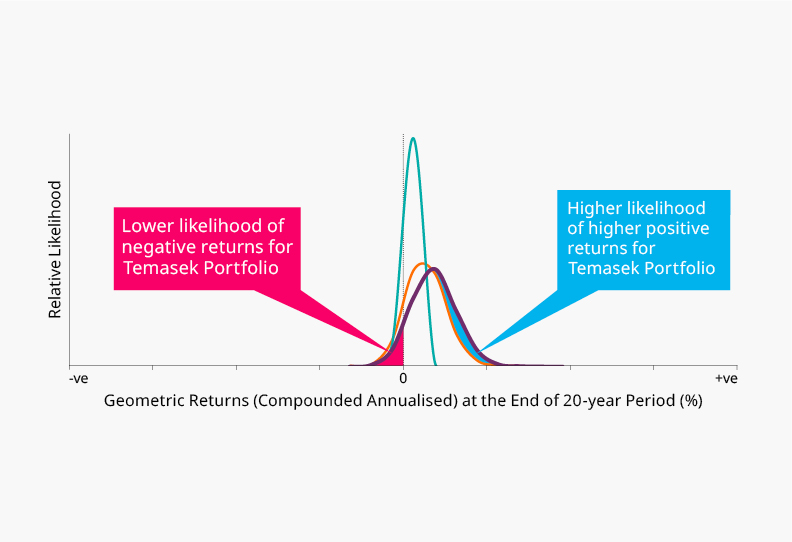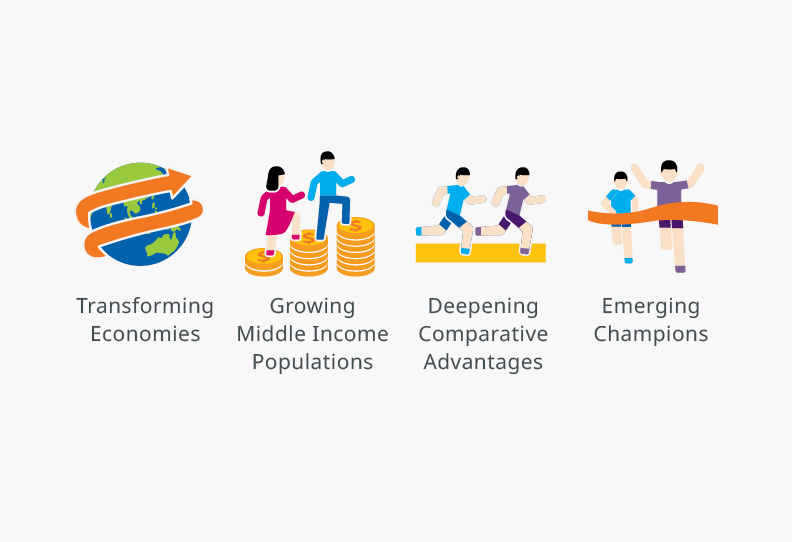How We Manage Risks
There are inherent risks whenever we invest, divest, or hold our assets, and wherever we operate.
We adopt a long term view of our investments, with the flexibility to take concentrated positions. We invest across all stages of a business life cycle, from early stage and unlisted, to large or listed assets. We do not have predefined concentration limits, or targets for investing by asset class, country, sector, theme or single name.
We consider environmental, social and governance factors, alongside other issues and risks, when we make decisions.
Our long investment horizon means we have a portfolio of mostly equities, including unlisted assets such as private equity funds, designed to deliver higher risk-adjusted returns over the long term.
Consequently, our portfolio is expected to have higher year-to-year volatility of annual returns, with higher risks of negative returns in any one year.
Our investment posture is to ride out such short term market volatility, and focus on generating sustainable long term returns.
We adopt a long term view of our investments, with the flexibility to take concentrated positions.
Our investment posture is to ride out such short term market volatility, and focus on generating sustainable long term returns.
Given the expected volatility, we manage our leverage and liquidity prudently for resilience and investment flexibility, even in times of extreme stress.
Our investment posture is coupled with a culture of risk awareness and balanced risk taking. This applies to both our investment activities and institutional capabilities. Our risk sharing compensation philosophy puts the institution above the individual, emphasises long term over short term, and aligns the interests of our staff with those of our shareholder.
We have no tolerance for risks that could damage the reputation and credibility of Temasek.
Organisational Risk Management Framework
Our Organisational Risk Management Framework includes Risk Return Appetite Statements (RRAS) which set out various levels of risks tolerance, from reputational risk, to liquidity risk and sustained loss of overall portfolio value over prolonged periods.
| RRAS 1 | We have no tolerance for risks that could damage Temasek’s reputation and credibility |
|---|---|
| RRAS 2 | We focus on performance over the long term |
| RRAS 3 | We have flexibility to take concentrated positions |
| RRAS 4 | We maintain a resilient balance sheet |
| RRAS 5 | We evaluate the potential for sustained loss of overall portfolio value over prolonged periods and use different scenarios to test our resilience |
To minimise operational risks, we embed risk management in our systems and processes. These include our approval authority delegation, company policies, standard operating procedures and risk reporting to our Board.
We have no tolerance for risks that could damage the reputation and credibility of Temasek.
Formalised processes instil the discipline to consider various perspectives. Investment proposals to our investment committee are submitted under a two-key system, for instance by both market and sector teams. Depending on the size or risk significance, these proposals may be escalated to our Executive Committee or Board for final decision. Functional teams provide additional specialist perspectives and independent reviews.
We consider environmental, social and governance factors, alongside other issues and risks, when we make decisions as an investor, institution and steward. Country and sector risks are factored into our risk-adjusted cost of capital for each investment. Our valuation discipline is based on our view on intrinsic value over longer horizons.
We track and manage risks proactively, through economic and market cycles, including specific risks at asset level.
We assess the potential sustained loss of our overall portfolio value, under various stress scenarios driven by significant event risks.
We do not manage our portfolio to short term mark to market changes.
For each scenario, we estimate the sustained impact on the intrinsic values of individual investments, in comparison with their original investment theses. The aggregate of these forms our view of the potential sustained loss of our overall portfolio value.
As illustrated in the diagram, the fundamental earnings impact is a sustained loss. This is different from the trough impact, which includes mark to market effect due to shorter term increases in risk aversion. We do not manage our portfolio to short term mark to market changes. We evaluate potential sustained loss of our portfolio under various stress scenarios, as part of our intrinsic value discipline.
Illustration of Fundamental Earnings Impact
Based on our assessments of any likely sustained loss, we may manage the risk as follows:
- Divest, hold or protect the individual investment impacted;
- Change the portfolio composition for the long run;
- Take actions to protect the portfolio.
In addition to scenario-based stress tests, we also monitor general market risk indicators such as the CBOE Volatility Index (VIX).
VIX Trend (March 2005 to March 2019)
Legal & Regulatory
We comply with all obligations under Singapore laws and regulations, including those arising from international treaties and UN sanctions. We also comply with the laws and regulations of jurisdictions where we have investments or operations.
Our global footprint, coupled with an ever-evolving legal and regulatory environment and increasing oversight by authorities, underscores the importance of robust compliance programmes. Our Legal & Regulatory department (LR) ensures that policies, processes and systems are appropriately designed, consistent with applicable laws, and aligned with Board directives. For instance, our policy on derivative transactions permits only personnel authorised by a board resolution to enter into such transactions within tightly defined scopes and limits on behalf of specific designated entities. LR also provides regular education and training on key policies and processes.
We comply with the laws and regulations of jurisdictions where we have investments or operations.
LR monitors regulatory reporting compliance through securities tracking systems. Regulatory requirements and monitoring systems are continually reviewed and updated to reflect changes in laws and regulations.
Our policy permits only personnel authorised by a board resolution to enter into derivatives transactions within tightly defined scopes and limits.
Our Temasek Code of Ethics and Conduct (T-Code) and its related policies guide our Board directors and staff in their daily dealings and conduct. With integrity as a key overarching principle, T-Code policies cover areas such as anti-bribery, whistle-blowing, management of confidential information, and prohibition against insider trading. Our annual staff bonus plans include T-Code compliance requirements.
Business Continuity and Incident Management
We are committed to continuously improve the way we manage business continuity risks. Our contingency management framework ensures business continuity and manages incidents arising from safety, physical and cyber security and other threats. The framework takes into account potential emerging risks and new responses enabled by technological advancements.
Global security, safety and health situations are monitored daily to support our staff, wherever they work. We also care for the well-being of our staff and their families during emergencies. As part of the Business Psychological Resilience Programme (B-PREP) organised by Temasek Foundation, we established a crisis supporter network to enhance emotional resilience in the event of a major crisis or workplace incident. We conduct response exercises, including full data centre recovery, on a regular basis to ensure that our contingency plans remain effective, relevant and adequate. A hot site is maintained for key staff to work at during emergencies.
We support communities in disaster-affected areas. In early 2019, we provided Bangkok residents Air+ Smart Masks and micro fans when they suffered from severe haze.



